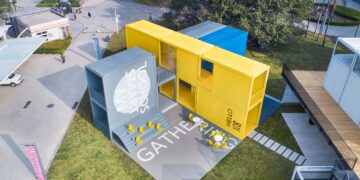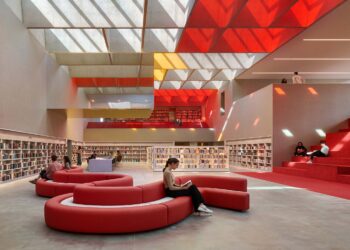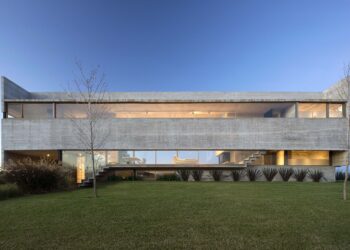A geometrically challenging new school agora is a metaphor for education itself
기하학적 구성요소로 새로운 교육 패러다임을 표현한 바야돌리드 엘 필라 학교의 열린 중정
Pablo Moreno Mansilla + Julián Zapata Jiménez | 파블로 모레노 만시야 + 훌리안 자파타 히메네즈

Architects Julián Zapata Jiménez and Pablo Moreno Mansilla have collaborated on a central agora for the Colegio Nuestra Señora del Pilar in Valladolid. Learning centers today face numerous challenges. The educational task is complex, and the design of schools must explore new ways of working. According to the architects, from the beginning, they interpreted the project as a metaphor for the difficulties we all encounter in our formative stages and throughout life. “Squaring the circle” is an unsolvable theorem, much like a one-size-fits-all approach to education. There are as many educating and learning styles as there are educators and students. The new agora is at the heart of the college. Located in the south courtyard, it is a perfectly circular shape inserted into a square. It functions as a meeting place, an event space and a locus for as many activities as there are students traveling through it.
스페인 바야돌리드의 ‘엘 필라 학교’는 1950년대에 설립된 유서 깊은 교육 시설로, 유치원부터 초, 중, 고등교육까지 통합적인 교육 프로그램을 제공하고 있다. 최근 이 학교에 ‘스페이스 아고라’라고 이름 붙인 새로운 공공공간이 마련되었다. 건물 한가운데 자리하는 중정으로, 리노베이션을 통해 기존의 예스러운 분위기를 벗고 빛으로 가득 찬 밝고 활기찬 공간으로 재탄생했다.
개인주의 풍조가 날로 만연해가는 현대 사회에서 지덕체를 두루 발달시키는 전인교육의 필요성은 점점 더 커져가고 있다. 이러한 패러다임이 비단 교육 프로그램에만 적용되는 건 아니다. 학교 건물도 그에 발맞춰 진화해야 한다. 리노베이션을 맡은 건축가는 여기서 디자인의 모티브를 얻었다. ‘인생의 성장 단계에서 마주하는 어려움’을 건축적으로 표현한 것이다.





While they do not presume to have solved the logical conundrum, the architects believe that they have put one solution into the hands of the college, a building which is respectful of the center’s history, versatile, capable of adapting to various activities and even accommodating those as yet unimagined. The new space is the result of a plastic, almost sculptural exercise. A new accessible ramp grows with a constant slope to form the space, becoming bleachers for seating. It becomes a tectonic exercise, like a playground where the topography does not force space, but frees the users’ imagination to conquer and make the place their own. This ascending circular ramp connects the access floor with the old main floor where the administrative, management and pastoral tasks of the center are carried out. The corners created by the circle’s positioning in the square become places of opportunity, offering space for small meetings, encounters with families, public presentations and cultural and leisure events.



이러한 발상으로 사각형의 건물 안에 원형 공간을 끼워 넣었다. ‘원을 사각형으로 만들기’라는 난제를 ‘모든 학생에게 적합한 교육 방식’이라는 개념으로 치환하여, 그 문제를 디자인적으로 풀어내는 과정 속에서 학생들의 다양한 개성을 품을 수 있는 방법을 탐색했다. 원을 사각형으로 만들어야 하는 난제 속에서 건축가들은 학교의 역사가 담겨 있고, 다용도로 활용 가능하며, 상상조차 못했던 다양한 활동을 가능케 해줄 공간이 탄생할 것이라고 믿었던 것이다.
실로 이렇게 만들어진 완벽한 원 모양의 중정은 학생들이 교류하는 만남의 장소이자 다양한 이벤트가 벌어지는 공간이 되었다. 뿐만 아니라 풍부한 조형적 요소를 품으면서 단조로웠던 기존 건물에 새로운 활력을 불어넣는다. 원의 테두리 쪽에는 경사로를 놓았는데, 이는 원을 따라 돌아가면서 점점 높이가 높아져, 어느 지점에 이르러서는 계단식 좌석으로 모습을 바꾼다. 사용자의 상상력을 자극함으로써 공공공간 속에서도 자신만의 영역을 가지게 해주는 매력적인 장치다. 점차 높아지는 순환형 경사로는 행정과 업무가 이루어지는 기존 건물의 메인 층과도 자연스럽게 연결된다.



The courtyard is covered by a mathematically structured wooden frame, which seems to sift the light. It converts what would be a simple roof over a patio into an altarpiece that looks up at the sky. The grid-like form helps to organize the space, while controlling the climatic conditions and irradiating light to all perimeter areas. The architects have successfully pursued the achievement of a transversal open space, where spaces – either visually or physically – constantly communicate with each other. From the access one can see the agora. From the agora one can see all the floors of the building, the chapel and the library. From the library, once can see the “silence room”, the administration offices, the lobby and the access platform. These cross-glances generate synergies and relationships – never indifference.
Crossed glances that generate synergies, relationships, never indifference.




사각형 속에 원을 삽입하면서 생겨난 모서리 공간들은 소규모 모임이 열리고 가족들과 만나고 강연과 문화 행사가 열리는 다용도 공간이 되었다.
천장으로 시선을 옮기면 실내로 빛을 흘려보내는 기하학적 구조의 목재 프레임이 눈길을 사로잡는다. 평범한 지붕이 될뻔했던 천장을 하늘과 맞닿은 멋진 배경으로 바꿔놓는 장치로, 자연 채광과 환기를 돕는 기능적인 역할도 한다.
이렇듯 건축가는 분리와 개방이 동시에 이뤄지는 광장을 조성함으로써 시각적으로, 물리적으로 끊임없이 교류하는 공간을 성공적으로 구축했다. 통로에서는 광장이 보이고, 광장에서는 건물 전 층과 성당, 도서관이 보이며, 도서관에서는 행정실, 로비, 통로가 눈에 들어온다. 이처럼 ‘스페이스 아고라’는 각각의 공간이 시각적으로 교차하며 끊임없는 시너지 효과와 상호 작용을 일으키는 곳이다.
Project: Espacio Agora, Valladolid / Location: Valladolid, Spain / Architects: Pablo Moreno Mansilla, Julián Zapata Jiménez / Collaborators: Iskra Sergeeva Martsenkova, Elena López Oterino, Manuel Sánchez Hernández, Adriana Culla Leal / Engineer: PLENUM Ingenieros / Structure: Jose Ignacio Viñals. ISTEN / Builder: Construcciones y Obras CASPEÑA S.L. / Client: Fundación Educación Marianista Domingo Lázaro / Site area: 8,629.53 m² / Gross floor area: 2,399.79m² / Completion: 2019.10 / Photograph: ©Alvaro Viera Architectural Photography




































